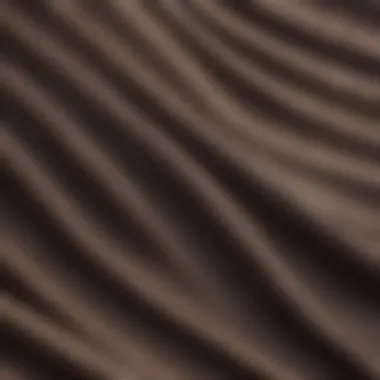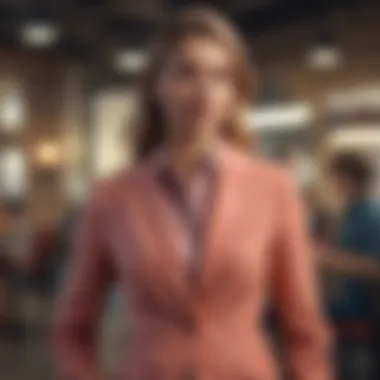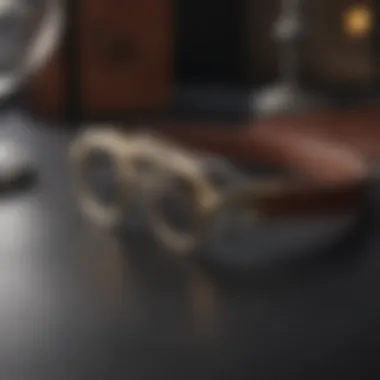Business Casual Fashion Trends of 2021


Intro
The landscape of work attire witnessed a notable shift in 2021, redefining the boundaries of what constitutes business casual. With the pandemic reshaping traditional workspace norms, professionals everywhere began to embrace a more relaxed, yet polished, approach to their wardrobe. This article untangles the web of trends that emerged during this year, highlighting how comfort, versatility, and style seamlessly integrated, catering to the needs of a workforce that straddled the line between home and office.
From tailored joggers to chic blazers made with stretchable fabrics, 2021's business casual attire evolved significantly, promoting a sense of individuality while ensuring appropriateness for professional settings. Packed to the brim with fresh ideas and innovated designs, business casual became a canvas for self-expression, allowing employees to bring a bit of their personality to the proverbial table. Let's dive into the details, exploring how various elements came together to define this year's fashion trends.
The Evolution of Business Casual
The business casual style has morphed significantly over the years, reflecting not just changes in workplace etiquette but also broader cultural shifts. This section aims to map out the unique journey of business casual attire, bridging the gap between traditional office wear and contemporary standards of dress. Grasping the evolution of this fashion trend is crucial, as it sheds light on how we express both professionalism and individuality in today’s world.
Historical Context
To appreciate where business casual stands today, one must take a step back and consider its roots. Historically, office attire was bound by rigid norms—think tailored suits for men and conservative dresses for women. In the late 20th century, particularly during the 1990s, brands like Dockers and Banana Republic began to popularize a more relaxed approach to workwear. This shift was partly influenced by the tech boom and the rise of startups in Silicon Valley where the mantra seemed to be "dress for comfort." As casual Fridays became a thing, employees started embracing khakis and polo shirts, laying the groundwork for what we now term business casual.
Shift to Remote Work
The last few years have seen a radical transformation in how we work, especially with a surge in remote working arrangements. Many individuals found themselves swapping their blazers for soft hoodies and fuzzy slippers, leading to a whole new understanding of what constitutes work attire. This shift generated a mix of comfort and professionalism which companies are now starting to embrace in flexible dress codes. With so many meetings happening in front of a webcam, the concept of "business on the top, casual on the bottom" emerged as a common mantra—highlighting the need to balance comfort and professionalism in a virtual environment.
Impact of the Pandemic
The COVID-19 pandemic acted as a catalyst for rethinking accepted workwear norms. With many workplaces shuttered and employees working from home, the typical dress code was tossed out the window. The emphasis placed on comfort led to an uptick in loungewear that often blurred the lines between home and office attire. Though many clung to professional shirts for video calls, the movement towards relaxed silhouettes and breathable fabrics grew stronger.
"The pandemic has pushed the idea that you can be productive while still being comfortable in what you wear while working from home."
As businesses begin to navigate a post-pandemic world, the lasting impact on business casual is evident. Styles that incorporate relaxed fits, soft textures, and versatile pieces are now becoming the norm. This evolution highlights an important realization—fashion can be both functional and stylish, allowing individuals to express their personal flair while still complying with professional expectations.
Key Elements of Business Casual Attire
In the realm of fashion, particularly within the context of professional environments, understanding the essentials of business casual attire is no small feat. This section dives into the vital components that not only define this dress code but also highlight its significance in fostering an image of professionalism while allowing a degree of personal expression. The balance between comfort and a polished appearance is the crux of the business casual movement, especially highlighted throughout 2021.
Breezy Tops
Material Selection
The backbone of any stylish look starts with the choice of fabric. For shirts and blouses, materials like cotton, linen, or blends are increasingly favored due to their breathability and comfort. The shift towards softer, more relaxed fabrics highlights a desire for ease in movement without skimping on the appearance of professionalism.
When selecting materials, consider how they drape and flow. A well-chosen fabric won’t wrinkle easily, and that means less ironing and a polished look throughout the day. Breathable fabrics like linen not only regulate temperature but also convey a sense of casual elegance, making them popular choices for workplaces aiming for modernity. Furthermore, more brands are leaning into sustainable materials which cater both to eco-conscious consumers and the desire for quality.
Fit and Style
Fit plays a pivotal role in how a top presents itself. An oversized button-down may suggest a laid-back attitude, while a tailored blouse or fitted shirt conveys intentions to be taken seriously. 2021 has seen increasing flexibility in fit; relaxed styles that maintain a structured appearance are now the norm.
The uniqueness here lies in the clever blending of safety and daring. A breezy top with a looser fit can be stylish when paired correctly, perhaps with tailored pants or chic accessories. However, it’s important to strike the right note; excessive bagginess might veer into sloppiness. The aim is always to tread that fine line between comfort and propriety.
Tailored Trousers
Design Trends
Trousers have shifted gears from rigid office wear to more versatile styles that encourage movement and variety. The tailored look has embraced elements like cropped lengths, wide-leg fits, and high waists, allowing for a fresh take on traditional design. This year, expectations around what constitutes 'formal' have loosened considerably, promoting an air of informal professionalism.


Emphasizing a relaxed but neat silhouette is beneficial, as people code dress through visual signals. Design trends in tailored trousers enable wearers not just to fit into a workplace but to depict the modern professional — someone who respects tradition yet isn’t afraid to push boundaries.
Color Variations
The days of monochrome uniforms largely have faded, making way for a kaleidoscope of color variations. Trousers in shades like navy, sage, and even soft pastels or earthy tones are common choices. This broad spectrum of colors allows professionals to express individuality while enriching the workplace atmosphere.
Investing in diverse hues opens the door for creative styling, enabling combinations that can suit different days or moods. However, while vibrant colors can uplift a look, a lack of caution may lead to clashes in the workplace. In doing so, industry professionals must carefully consider their choices in context, favoring options that harmonize with their overall attire.
Chic Footwear
Comfort vs. Style
Footwear often sits at the crossroads of comfort and style, where the choices made can define one’s entire look. Very much in 2021, we see a trend prioritizing not just aesthetics but functionality. For instance, loafers and smart sneakers have moved from casual wear to acceptable business casual options, offering a distinctive yet cozy alternative to traditional heels or formal shoes.
Choosing footwear that provides ample comfort supports the daily demands of professional life - standing, walking, and moving between meetings. Yet, the aesthetics can't be ignored; shoes should still feel sleek and polished. When these elements connect, they forge a well-rounded appearance that resonates with contemporaneous office culture.
Popular Brands
Acknowledging particular brands within the sphere of chic footwear can provide insights into current trends. Brands like Clarks, Ecco, and Allbirds have pushed the envelope, marrying functional designs with fashionable elements. Such brands emphasize sustainable practices and materials, catering to a clientele that values ecologically-conscious choices.
However, one must evaluate that brand prestige does not overshadow comfort when investing in a pair of shoes. Striking the right balance between brand aspiration and personal comfort levels remains vital in determining if a footwear choice enhances the intended business casual vibe.
Accessorizing Right
Jewelry Choices
When it comes to accessorizing, jewelry can elevate an outfit from ordinary to extraordinary. However, the line between too much and just the right amount is as thin as a thread; minimalism generally reigns in office settings. Delicate necklaces, subtle earrings, or watches can add a touch of elegance without overwhelming the attire.
Beautiful options don't just influence the appearance but also play a role in personal confidence. Choosing pieces that resonate with personal style while maintaining professionalism allows for articulation of individuality within the corporate environment without crossing over into distraction.
Bags and Briefcases
Finally, the bags we carry can make a lasting impression. Investing in a well-crafted briefcase or tote can add sophistication to even the most basic of looks. The trend in 2021 has shifted towards bags that reflect personal style while being practical for daily use.
Choosing styles with simple lines and classic shapes enhances long-standing trends while also offering adaptability for various settings. An excellent bag can underscore an expert image while seamlessly accommodating the necessities of a busy workday, proving that function and flair can successfully coexist.
Emerging Styles in
The landscape of business casual clothing saw some striking developments in 2021. This section dissects the key emerging styles that carved their unique niche in the fashion industry— an interplay of relaxation, minimalist aesthetics, and vibrant expressions. Each of these styles proved to be essential in guiding individuals as they navigated a new realm of professional attire influenced by shifting workplace dynamics and lifestyle preferences.
Loungewear Meets Professionalism
The phrase "loungewear meets professionalism" didn't just capture attention; it redefined it. In 2021, with remote work becoming commonplace, professionals sought clothing that felt as good as it looked. What does this mean fundamentally? It emphasizes comfort without sacrificing style. Stretchy fabrics, soft lines, and laid-back silhouettes became the heroes of the daily work attire, with brands like Everlane and Athleta leading the charge. This move wasn't merely about broader acceptance of casual wear; it posed a statement about prioritizing comfort in professional settings.
- Key elements of this trend include:
- Soft, breathable materials: Fabrics like modal and bamboo caught on for their comfort.
- Tailored sweatpants: A step away from the joggers that took the world by storm earlier. These trousers were designed to fit nicely without the stiffness typical of traditional pants.
- Chic hoodies: No longer just for lounging, a well-cut hoodie became an acceptable choice for video calls.
The melding of these ideas encouraged a mindset shift; you could do business comfortably, blending homey vibes with the seriousness of work.
The Rise of Minimalism


Minimalism made a solid comeback in 2021, reminding us all that less can indeed be more. This philosophy emphasized simple lines, muted colors, and an overall clean look. Not to say there wasn’t room for creativity; it challenged individuals to think more about their choices in fashion, opting for versatile pieces that could be worn in various contexts.
- Characteristics of minimalist style:
- Monochromatic color schemes: Shades like beige, navy, and grey dominated wardrobes, allowing easy mixing and matching.
- Clean silhouettes: Simple shifts, tailored blazers, and structured skirts replaced extravagant cuts.
- Quality over quantity: Minimalism also pushed toward sustainable choices, focusing on pieces that were ethically produced and designed to endure—think brands like Reiss and COS.
The minimalist approach appealed not just to aesthetic preferences but also to a growing desire for responsible consumption and thoughtful living.
Bold Prints and Patterns
If minimalism was about simplicity, then the bold prints and patterns trend shouted vibrancy and character. 2021 saw a paradigm shift where professionals felt emboldened to experiment with colors and patterns that previously might have felt out of place in traditional office settings. This vibrant trend included striking floral patterns, geometric shapes, and even skin-inspired colors, capturing a certain joy often masked under formal wear.
- Noteworthy aspects of this trend:
- Floral prints: Women began to incorporate beautiful floral dresses or blouses, signaling a connection with nature's vibrancy while still being work-appropriate.
- Geometric patterns: Men and women alike chose shirts and dresses featuring sharp lines and bold shapes, breaking the monotony of solid colors.
- Animal prints: A staple that resurfaced, animal motifs seen in smart casual settings emphasized a bold approach to business casual.
Collectively, these trends fostered a culture of individuality and creativity. People were encouraged to express themselves more freely in their professional attire, breaking the chains of the past with newer, bolder expressions of personal style.
Color Trends in Business Casual
Color in business casual attire isn’t just about personal preference. It serves as a powerful communicative tool in professional environments, subtly conveying messages about personality, authority, and creativity. In 2021, businesses and individuals alike sought to redefine workplace norms through their color choices. As the lines blurred between the office and home life due to remote work, the trends reflected a yearning for comfort, vibrancy, and individuality. Understanding the impact of colors can enhance professional appearance while simultaneously allowing one’s personality to shine through.
Neutrals vs. Vibrants
In the realm of business casual, neutrals and vibrant colors often tug at fashion lovers' hearts, like two old friends with differing views.
- Neutrals: These colors – think soft whites, grays, and earthy tones – dominated many wardrobes in 2021. They offered a safe haven for professionals who were navigating the shift to remote work while keeping a polished look. Neutrals are versatile, allowing for pairing with bolder accessories or statement pieces without screaming for attention. They foster a sense of calm, which many reported wanting while juggling home responsibilities and work tasks.
- Vibrants: On the flip side, vibrant colors surged ahead. Bright yellows, rich greens, and deep blues provided a refreshing contrast to the sometimes monotonous backdrop of remote work. These hues were often integrated into tops or accessories, targeting individuals who wish to stand out in virtual meetings or when finally stepping into the office.
"Your choice of colors reflects your mood and personality. In uncertain times, brightness can be a comforting choice."
Combining neutrals with vibrant pieces can create a balanced outfit that resonates with creativity while maintaining professionalism. For example, pairing a vibrant top with tailored gray trousers can both impress colleagues and uplift one’s own mood.
Seasonal Color Palettes
Different seasons bring with them a sense of renewal and change, and business casual wear in 2021 was no different. Two specific palettes emerged as distinct favorites:
- Spring/Summer: Light pastels and soft shades dominated during the warmer months. Colors like mint green, sky blue, and soft peach whispered of optimism and growth. Professionals often selected breathable fabrics in these hues, aligning comfort with an airy aesthetic. Wearing such colors can enhance visibility in meetings, making one feel more energetic.
- Fall/Winter: When the weather turned colder, the palette shifted to deeper tones. Rich burgundies, mustard yellows, and forest greens came to the forefront, bringing a sense of warmth and coziness. These colors can elevate the mood, making the often-dim winter days feel brighter. Opting for a cozy sweater in one of these colors can set a laid-back but professional ambiance even on the most gray of days.
Understanding color trends in business casual attire for 2021 was crucial for making a compelling visual statement in an evolving work environment. These trends not only reflect personal style but also encapsulate the spirit of adaptability and resilience that the modern workplace demands.
Fabric Choices and Sustainability
As the world shifts towards more conscientious living, fabric choices in business casual attire take center stage. In 2021, sustainability became not just a buzzword but a necessity. The importance of choosing fabrics that align with environmental concerns plays a pivotal role in modern business casual clothing. Companies and individuals alike started recognizing that garment production impacts not only the planet but also the communities involved in creating these materials.
When selecting fabrics, several considerations emerge:
- Source of Material: Are the materials sourced responsibly? Opting for organic cotton or linen is often preferred over conventional cotton due to its reduced chemical footprint.
- Production Practices: The method of production should minimize waste and energy consumption, thereby supporting eco-friendly initiatives.
- Durability: Fabrics that last longer reduce the frequency of replacements, which significantly cuts down on waste.
- End-of-Life Considerations: Choosing materials that can be recycled or biodegraded contributes to a circular fashion model.
By aligning fabric choices with sustainable practices, consumers can influence the fashion industry in meaningful ways, pushing brands to improve and innovate.


Eco-friendly Materials
Eco-friendly materials emerged as a linchpin in the business casual domain of 2021. Many retailers began showcasing fabrics that are not only stylish but also environmentally friendly. Some leading materials gaining traction include:
- Tencel: Known for its softness and breathability, Tencel is derived from sustainably harvested trees and produced in a closed-loop system that recycles water and solvents.
- Recycled Polyester: This fabric is made from post-consumer plastic bottles, offering durability while keeping waste out of landfills.
- Hemp: Offering a robust alternative, hemp requires less water and grows quickly compared to cotton, making it a sustainable choice for casual wear.
Choosing these materials isn’t merely a fad; it's a choice towards sustainability that can reshape how business casual is perceived. Each conversation about clothing choices can spotlight broader issues of manufacturing processes and consumer habits.
Comfort in Performance Fabrics
In a world increasingly leaning towards comfort, performance fabrics have made waves in the realm of business casual wear. These specialty textiles not only provide ease of movement but also boast practical features.
Characteristics of performance fabrics:
- Moisture-Wicking Properties: Ideal for those long hours at the desk, these fabrics pull sweat away from the body, keeping wearers dry and comfortable.
- Enhancing Breathability: Fabrics designed with breathability allow for air circulation, which can help maintain comfort in different work environments.
- Stretch and Recovery: Spandex blends often provide the flexibility needed for active movements without losing shape, making any outfit look sharp and professional.
Consumers are more discerning now than in the past, seeking not just a polished look but also functionality in their wardrobe choices. Performance fabrics serve as a bridge, merging comfort with professional aesthetics, and are becoming a staple in the business casual landscape.
Final Thought: The fabric choice reflects not just personal style but an awareness of the impact fashion can have on the world. By opting for sustainable and functional materials, one can contribute to a more responsible wardrobe.
Navigating Dress Codes
Understanding the different dress codes and navigating them effectively is crucial in the modern workplace. For many, the line between formal and casual can feel blurred, especially with how the pandemic has reshaped our professional environments. Knowing the ins and outs of business casual attire can enhance one’s image and contribute positively to workplace dynamics. Here’s a deep dive into how to navigate these dress codes with flair and confidence.
Understanding Company Culture
Every organization has its own vibe. The definition of business casual doesn't look the same from one office to another. A tech startup, for instance, may embrace a more relaxed approach compared to a law firm, where a conservative style prevails.
It's important for employees to grasp their company's culture. Understanding what's accepted can help avoid any fashion faux pas that might draw unwanted attention. To get a feel for this, new hires should:
- Observe what others wear. Take note of your colleagues. Are blazers rare, or are they part of the daily wardrobe?
- Ask questions. It's perfectly fine to inquire about attire during orientation or within informal conversations.
- Adjust accordingly. If you notice a more relaxed style on casual Fridays, perhaps ease into that by selecting comfortable yet professional pieces.
Company culture plays a significant role. It’s more about feeling confident in what you're wearing than just adhering to a guideline. If you blend in well, you’ll feel more comfortable and likely perform better.
Adapting to Different Settings
Not every meeting or social setting calls for the same outfit. A presentation to the board could require a more polished look, while a casual lunch out with team members might lean towards a relaxed dress code. Adapting means having a flexible wardrobe that speaks to the situation at hand. Here’s how you might think about it:
- Client Meetings: These should lean toward the polished side - think tailored trousers paired with a smart shirt or blouse,
- Casual Fridays: This is where the business casual nature really shines. A nice polo with chinos, or a breezy dress can hit the mark without seeming too laid back.
- Company Events: Each might have its own theme. Whether it’s a holiday party or a networking function, understanding what vibe you need to embody is key for a successful outfit choice.
In a world where the distinction between work and home is becoming less defined, having a keen sense of what to wear and when can save you from unnecessary stress. Feeling brilliant in your attire can help you focus, allowing skills and creativity to shine through, undiminished by uncertainty about dress codes.
The Future of Business Casual
As work environments continue to undergo a significant transformation, understanding the trajectory of business casual attire becomes increasingly crucial. The shift initiated by recent global events has not only impacted how we perceive professionalism but also how we express individual style in a workplace setting. The future of business casual is about blending traditional elements with contemporary preferences, yielding a style that is both suitable for work and reflective of personal identity.
Anticipated Trends for
Looking ahead to 2022, several trends appear poised to take center stage in the realm of business casual.
- Sustainable Fashion: There is a marked increase in environmental consciousness among consumers. Expect to see more brands integrating eco-friendly practices, from sourcing materials to production processes. Fabrics made from recycled materials or organic fibers are likely to populate the business casual landscape, aligning with a broader societal shift toward sustainability.
- Comfort First: With the continued prevalence of hybrid work models, the focus on comfort is likely to endure. This means a rise in relaxed silhouettes that remain polished. Think tailored joggers paired with stylish blazers or dresses that combine elegance with stretchable fabrics.
- Bold Accessories: Accessories are becoming more expressive, serving as a counterbalance to minimalist clothing options. Expect a surge in statement jewelry, vibrant bags, and eye-catching footwear that elevate basic outfits into something memorable.
Evolution of Workplace Attire
The evolution of workplace attire isn't just a passing phase; it marks a fundamental shift in how we view professionalism and personal expression within the workplace. No longer are rigid dress codes the norm. Instead, we now see a blending of casual elements into business wear, allowing for greater personal expression without sacrificing professionalism.
- The Role of Technology: With remote work technologies becoming standard, employees are less concerned about traditional office attire and more focused on what conveys their brand as professionals. This shift will likely encourage individuals to adopt styles that reflect their unique identities while still looking polished for virtual meetings.
- Diverse Inspirations: Inspired by various sources—streetwear, activewear, and even high fashion—future business casual styles will likely borrow elements from a wide range of cultural influences. This rich tapestry of sources will result in a more diverse and dynamic work wardrobe.



